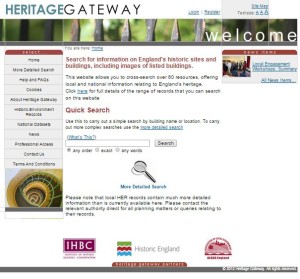Hydraulic fracturing (fracking) draft regulations have now been released, defining areas in which the activity would be prohibited, though the Campaign to Protect Rural England (CPRE) has criticised the omission of Sites of Special Scientific Interest (SSSIs) from the protected area definitions, and the independent ‘Task Force on Shale Gas’ released its report into local environment and health.
The Department of Energy and Climate Change (DECC) writes:
Areas to be excluded from underground fracking activities have been set out by the Government today, through draft regulations that define the protected areas in which fracking will be prohibited.
The draft regulations set out further protections for groundwater and National Parks, Areas of Outstanding National Beauty, the Broads and World Heritage Sites, ensuring the process of hydraulic fracturing can only take place below 1200 metres in these areas. Drinking water is not normally found below 400m.
Ministers also set out their clear commitment to ensure that fracking cannot be conducted from wells that are drilled in the surface of National Parks and other protected areas in such a way as to not impact on conventional drilling operations. More details on this will follow shortly.
Energy Minister Andrea Leadsom said: ‘The UK has one of the best track records in the world when it comes to protecting our environment while also developing our industries – and we’ve brought that experience to bear on the shale gas protections. We need more secure, home grown energy supplies, and shale gas and oil have a vital role to play – much better that we use what we have at home than relying on supplies from volatile foreign imports. This industry will be developed safely with world class environmental protections, creating jobs and delivering better energy security while safeguarding of some of our most precious landscapes.’
CPRE has criticised the omission of SSSI’s from the protected area definitions, and writes:
The Government previously committed to limiting fracking in protected areas. In advance of new legislation defining these limits, the Campaign to Protect Rural England (CPRE) and other conservation organisations wrote to the Secretary of State for Energy and Climate Change to exclude fracking from the most sensitive parts of our countryside.
Following the Government laying draft secondary legislation in Parliament to define protected areas, Nick Clack, senior energy campaigner at the Campaign to Protect Rural England (CPRE), comments: ‘Although the Government has included National Parks, Areas of Outstanding National Beauty and World Heritage Sites in the definition of protected areas, it has gone back on its previous promise to also include Sites of Special Scientific Interest. It has also ignored our request to ban fracking underneath these areas to prevent unnecessary negative impacts from drilling rigs next to these sites, which would harm their tranquillity and people’s enjoyment of them. Despite the Government reiterating its intention to rule out fracking from wells that are drilled within National Parks and other protected areas, the Government has not included anything in the legislation to bring this into effect. It is not clear how or when this might happen and we are now looking for the Government to back up its words with the necessary safeguards.’
The Task Force on Shale Gas writes:
The Task Force on Shale Gas today released its second report on the impact of a fracking industry on the UK, specifically assessing local environmental and health impacts. The report assessed the available evidence on the potential local environmental and health impacts of a shale gas industry in the UK and made a series of recommendations.
Specifically the Task Force recommends:
- Full disclosure by shale gas operators of the chemicals being used in their operations – with Environment Agency monitoring on site to confirm additive levels are within agreed and safe limits
- Baseline monitoring of groundwater, air and soil to be established at the moment a potential site is identified, with community representatives given an oversight role in monitoring and all results made public. Current planning regulations that require full planning consent before boreholes can be drilled for monitoring should be changed
- Operators to commit and be held to the very highest standards in well construction, independently monitored. The Task Force found many of the problems associated with shale gas derived from historical poor practice in the United States, rather than the process of fracking itself. This situation can and must be avoided in the United Kingdom
- The process of ‘green completions’ – whereby fugitive methane emissions are minimised on site – should be mandatory for production wells
- The disposal of wastewater by deep injection – which has been associated with earthquakes in the United States – should be avoided in the United Kingdom in line with current Environment Agency practice, particularly where the nature of the geology is unsuitable
- A National Advisory Committee should be established to monitor data from shale gas operations if and when they are established in the United Kingdom to provide an independent analysis of actual and potential impacts on public health to both policymakers and the public
- Public Health England should commit to reassessing and evaluating its report into the health impacts of shale gas once a statistically significant number of wells have been established and data is available. All results and conclusions must be made public
Lord Chris Smith, chair of the Task Force on Shale Gas said: ‘Our conclusion from all the evidence we’ve seen is clear. Only if the drilling is done properly and to the highest standard, and with rigorous regulation and monitoring, can shale gas fracking be done safely for local communities and the environment. We highlight four essential ingredients for safe operation: full disclosure of chemicals; baseline monitoring from the outset; strong well integrity, independently regulated; and ‘green completions’ to contain the gas that’s created and minimise emissions. The evidence shows that many of the concerns associated with fracking are the result of poor practice elsewhere in the world, such as poorly constructed wells.’
‘It is therefore crucial that stringent regulations are established in the UK, as set out in our recommendations, in order to meet these legitimate concerns. We also recommend the formation of a National Advisory Committee to examine, collate and evaluate health impacts associated with shale gas operations once they have begun and data from the first wells becomes available.’
The recommendations follow months of academic review, visits to communities potentially affected by fracking, input from industry, experts, campaigners and relevant associations. To underline the scientific and robust nature of its report the Task Force has also simultaneously published a briefing document which sets out the scientific foundations of its findings.
‘Our guiding principle is to provide trusted, factual and impartial information that people need in order to make up their own minds about shale gas,’ said Lord Chris Smith, ‘With this second report the Task Force has reviewed evidence, visited shale gas sites and met with experts and communities, all of which has informed our environmental and health recommendations. We look forward to the public’s response.’ The Task Force will publish two further reports in 2015 covering climate change and economics. A final report on the potential risks and benefits of shale gas for the UK will be published as the culmination of the Task Force’s research in the spring of 2016.
The Task Force on Shale Gas was launched in September 2014 to give careful consideration to public concerns, and to provide an impartial and transparent assessment of the potential benefits and risks of shale gas extraction to the UK.
View the DECC press release
View the draft regulations
View the CPRE press release
View the Task Force on Shale Gas press release and report
Search Planning Portal
IHBC NewsBlogs on energy
IHBC on rural issues and protected areas


